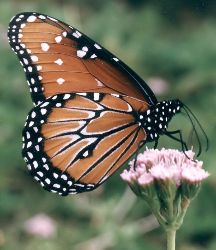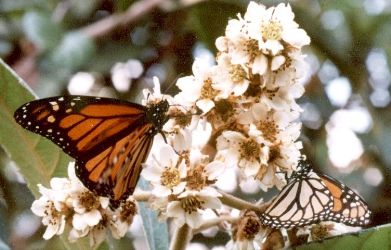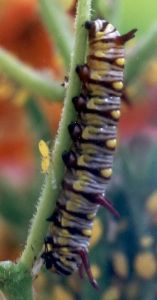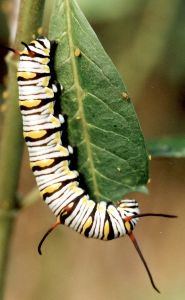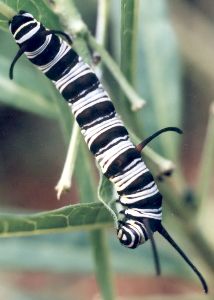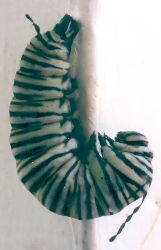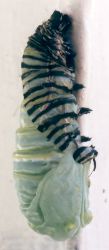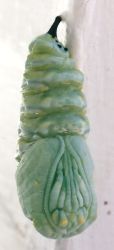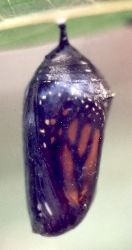Monarchs and Queens
by Valerie (June 30, 2000)
revised October 31, 2003
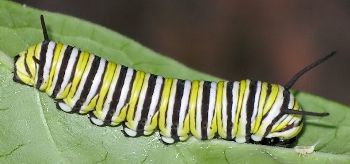
There are a lot of species of milkweed that grow in this area, from the several types of wild ones to the decorative orange and yellow blossomed garden varieties called butterflyweed. With so many host plants, it is not surprising that the milkweed butterflies are often quite numerous. The photo at right shows a monarch caterpillar. I've often seen two species in this area: the monarch (Danaus plexippus) and the queen (Danaus gilippus). Both have larvae that feed on milkweed and both are large orange butterflies. For some reason, I've seen more monarch larvae on wild milkweeds, while the queens tend to monopolize the garden flowers. The caterpillars of each species seem to be more numerous at different times. I might see only queen caterpillars one day and then only find monarchs another time.
The queen butterfly, above at left, is darker than the monarch, at right, and lacks the strong black lines on the upper sides of its wings. The adults often occur in large numbers around nectar plants such as purple mist flowers. The caterpillars are similar to those of the monarch, with yellow, black and white stripes, but have an extra pair of long projections sticking out about one third of the way down their bodies. When queen caterpillars are very young, they have small yellow bumps that look a lot like the aphids that are often all around them on the same plants. These bumps later just become color markings on the bigger caterpillars. However, some of the caterpillars are missing the yellow color and appear to be just black and white. The photos below, all taken at Zilker Gardens in Austin, show, from left to right, a young caterpillar, an older normally colored caterpillar, and a dark colored caterpillar of about the same age.
Monarchs are most noticeable during their spring and fall migrations when they move between northern areas of the U.S. and Mexico. They are sometimes ragged looking from their long journeys and stop to get drinks in any water that's available or feed at whatever flowers are blooming. The caterpillars are very familiar to most people with their striking yellow, white and black stripes and long fleshy pairs of appendages at both ends. When the caterpillar is ready to pupate, it attaches itself to a plant or building at the rear with a little pad of silk, then sheds its skin. The green pupa is bumpy and soft before it finally hardens into the smooth, jewel-like chrysalis. Just before the butterfly is ready to emerge, the walls of the chyrsalis become clear and the wings of the adult butterfly are visible. This sequence of photos showing the metamorphosis from caterpillar to pupa was taken on the porch of a farmhouse in Waco. The final chrysalis picture was taken at Zilker Gardens in Austin.
|
